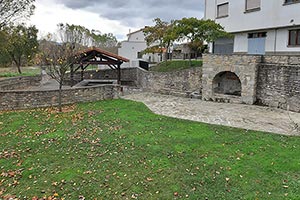Cultural heritage of Ororbia
Water architecture: source and laundry, black water and mill.
The source and the washing place located next to the Arga River were built in 1806, when the springs that traditionally supplied the town dried up. The project consisted of gathering the water from several springs in an ark, from where it comes out through a small vaulted building opened by means of a semicircular arch. The water is conducted from the source to a trough and then to a covered washhouse. In spite of this work, water shortages were frequent during the summer, something that was alleviated thanks to the generosity of the neighbors, who provided water from the wells located in their homes. It was not until 1956 that the supply of water from the Ulzurrun springs was established.
On the river promenade, near the bridge, is the source of the black water, which is so named because of the dark tone it acquires after a few days. It is a source to which healing properties were attributed, especially against skin diseases. The most important ritual took place on St. John's Day, when many outsiders came to Ororbia to drink and wash themselves with the water from the source. The rest of the year visitors also came, especially women, to take the "novenario", which consisted of drinking the water for nine consecutive days. Likewise, pitchers were filled for different towns in Navarra, in order to provide water to those who could not travel. The heyday of the black water took place in the 19th century, becoming a lucrative business for the council. However, in the first decades of the following century the custom would languish and today the source is closed, paradoxically, due to lack of sanitation.
On the other side of the bridge, the path that starts next to Wayside Cross leads to the mill and the orchards of La Barasta. The mill, today adapted as a house, is a three-story building of plastered stone that partially preserves the machinery inside. Its system of dams, located on both sides of an island in the Arga River, and the irrigation ditch that carried the water, also survive. Of medieval origin, at least from the 14th century, it was a local mill that eventually became the property of only four families. It served Ororbia and the surrounding villages, and had two millstones for grinding grain, one of which was used for corn from the 18th century onwards. It was not the only mill in the village, since on the left bank of the Arga, upstream, the mill of Echamur is documented. The Order of St. John of Jerusalem acquired it from a noblewoman in 1186 and owned it until withdrawal in the 17th century.
ALEGRÍA SUESCUN, D., Flour Mills of Ororbia. Historical-documental study, Concejo de Ororbia, 2015.
GUIJARRO SALVADOR, P., Ororbia: a thousand years of history, Concejo de Ororbia, Kybse, 2015.
MARTÍNEZ ÁLAVA, C. J., TARIFA CASTILLA, M.ª J. and LATORRE ZUBIRI, J., La iglesia de San Julián de Ororbia. History and restoration, Concejo de Ororbia. Foundation for the Conservation of the Historical Heritage of Navarre. Graftech Ibérica, 2014.
ZUBIAUR CARREÑO, F. J., "Catalog de miradas. La Navarra que fotografió Nicolás Ardanaz", in Ricardo Fernández Gracia (coord.), Pvlchrvm: Scripta varia in honorem M.ª Concepción García Gainza, Gobierno de Navarra. University of Navarra, 2011, pp. 838-846.
transcript del Asilo San José: file Contemporáneo de Navarra/Vivienda/1116846.











